
NGC 2903 is an isolated barred spiral galaxy in the equatorial constellation of Leo, positioned about 1.5° due south of Lambda Leonis. It was discovered by German-born astronomer William Herschel, who cataloged it on November 16, 1784. He mistook it as a double nebula, as did subsequent observers, and it wasn't until the nineteenth century that the Third Earl of Rosse resolved into a spiral form. J. L. E. Dreyer assigned it the identifiers 2903 and 2905 in his New General Catalogue; NGC 2905 now designates a luminous knot in the northeastern spiral arm.

NGC 514 is a low-luminosity, intermediate spiral galaxy in the equatorial constellation of Pisces, located at a distance of approximately 83 million light-years from the Milky Way. It was discovered on 16 October 1784 by astronomer William Herschel. The general form of the galaxy is specified by its morphological classification of SAB(rs)c, which indicates it has a weak bar system at the core (SAB), an incomplete ring formation around the bar (rs), and somewhat loosely-wound spiral arms (c). This galaxy has an H II nucleus with an extended region that displays weak emission lines in the optical range, but not in the near infrared. The suspected supermassive black hole at the core has an estimated mass of 3.2×106 M☉.

NGC 5879 is an unbarred spiral galaxy in the constellation Draco. The galaxy was discovered in 1788 by William Herschel. It is a member of the NGC 5866 Group.
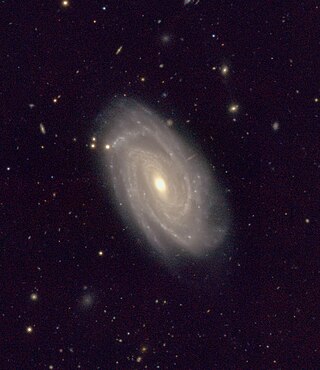
NGC 10 is a spiral galaxy located in the southern constellation of Sculptor. It was discovered by John Herschel on 25 September 1834. The galaxy is located at a distance of 346 Mly from the Sun. Its morphological classification in the De Vaucouleurs system is SAB(rs)bc, where the 'SAB' denotes a weak-barred spiral, '(rs)' indicates a slight ring-like structure, and 'bc' means the spiral arms are moderately to loosely wound. Paturel et al. (2003) assigned this galaxy a classification of SBbc, indicating a barred spiral galaxy.

NGC 23 is a spiral galaxy located in the northern constellation of Pegasus, around 173.5 megalight-years distant from the Milky Way. It was discovered by William Herschel on 10 September 1784. In the Webb Society Deep-Sky Observer's Handbook, the visual appearance of NGC 23 is described as follows:
Bright, extended ellipse; a bright nuclear structure is noticeably elongated; two weak spiral enhancements emerge from opposite sides of the nucleus, one curving towards a bright star attached on the south end. The galaxy is likely interacting with NGC 9.

NGC 24 is a spiral galaxy in the southern constellation of Sculptor, about 23.8 megalight-years distant from the Milky Way. It was discovered by British astronomer William Herschel in 1785, and measures some 40,000 light-years across. The general shape of this galaxy is specified by its morphological classification of SA(s)c, which indicates it is an unbarred spiral with no ring-like structure and moderate to loosely-wound spiral arms. This galaxy is positioned in the vicinity of the Sculptor Group, but is actually a background object that is more than three times as distant. It may form a pair with another background galaxy, NGC 45.
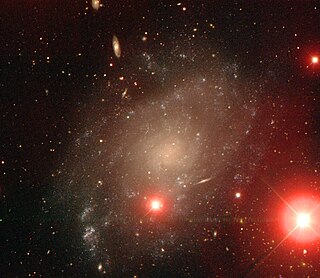
NGC 45 is a low surface brightness spiral galaxy in the equatorial constellation of Cetus. It was discovered on 11 November 1835 by the English astronomer John Herschel. The galaxy is located at a distance of 22 million light years and is receding with a heliocentric radial velocity of 466 km/s. It is located in the vicinity of the Sculptor Group, but is most likely a background galaxy.
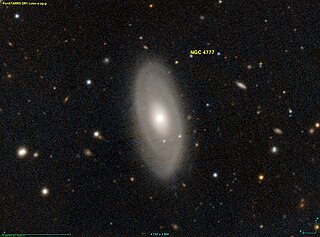
NGC 4777 is an intermediate spiral ring galaxy. It is estimated to be about 180 million light-years away from the Sun. It was discovered on March 3, 1786 by the astronomer William Herschel.

NGC 3223 is a faint spiral galaxy in the constellation Antlia. It was discovered on February 2, 1835 by the English astronomer John Herschel. The galaxy lies at a distance of approximately 110 million light years away and is receding with a heliocentric radial velocity of 2,896 km/s. The morphological class of NGC 3223 is SA(s)b, indicating it is a spiral with no central bar (SA), no inner ring feature, and moderately tightly wound spiral arms. The galactic plane is inclined at an angle of 46° to the line of sight from the Earth, with the major axis along a position angle of 128°. It has at least two well-defined arms and is flocculent in appearance.
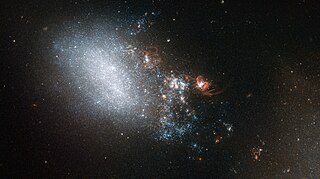
NGC 4485 is an irregular galaxy located in the northern constellation of Canes Venatici. It was discovered January 14, 1788 by William Herschel. This galaxy is located at a distance of 29 million light years and is receding with a heliocentric radial velocity of 483 km/s.

NGC 4217 is an edge-on spiral galaxy which lies approximately 60 million light-years away in the constellation of Canes Venatici. It is a possible companion galaxy to Messier 106.
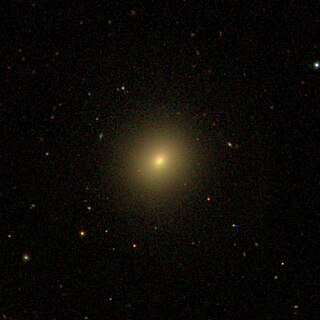
NGC 113 is an unbarred lenticular galaxy located in the constellation Cetus. It was discovered by German astronomer, Ernst Wilhelm Leberecht Tempel, on August 27, 1876.

NGC 1084 is an unbarred spiral galaxy in the constellation Eridanus. It is located at a distance of about 63 million light-years away from the Milky Way. The galaxy was discovered by William Herschel on 10 January 1785. It has multiple spiral arms, which are not well defined. It belongs in the same galaxy group with NGC 988, NGC 991, NGC 1022, NGC 1035, NGC 1042, NGC 1047, NGC 1052 and NGC 1110. This group is in turn associated with the Messier 77 group.

NGC 2865 is an isolated elliptical galaxy in the equatorial constellation of Hydra. The core region of the galaxy shows a kinematically distinct component showing indications of a recent accretion or merger event that led to a burst of star formation around the nucleus. Observational constraints require this to have occurred within the last 100–400 million years, with the merger most likely being an Sb or Sc-class spiral galaxy.

NGC 4380 is an unbarred spiral galaxy located in the constellation of Virgo. Located about 52.2 million light-years away, is a member of the Virgo Cluster, a large galaxy cluster. It was discovered on March 10, 1826 by the astronomer John Herschel.

NGC 3175 is a spiral galaxy located in the far eastern part of the southern constellation of Antlia at an approximate distance of 54 million light-years. NGC 3175 was discovered on March 30, 1835 by English astronomer John Herschel, whose notes described it as, "considerably bright, large, much extended NE-SW, very gradually little brighter middle". This galaxy is the namesake of the NGC 3175 group of galaxies, which includes the spiral galaxy NGC 3137.

NGC 812 is a spiral galaxy located in the Andromeda constellation, an estimated 175 million light-years from the Milky Way. NGC 812 was discovered on December 11, 1876 by astronomer Édouard Stephan.
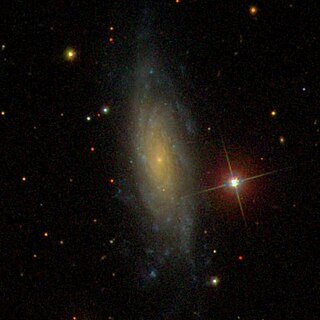
NGC 803 is a spiral galaxy located in the constellation Aries about 70 million light-years from the Milky Way. It was discovered by the German–British astronomer William Herschel in 1784.

NGC 941 is an intermediate spiral galaxy in the constellation Triangulum. It is an estimated 55 million light-years from the Milky Way and has a diameter of approximately 55,000 light years. The galaxies NGC 926, NGC 934, NGC 936, NGC 955 are located in the same sky area. NGC 941 was discovered by the astronomer William Herschel using on 6 January 1785.

NGC 3005 is an edge-on spiral galaxy in the constellation of Ursa Major, discovered by Bindon Stoney on January 25, 1851. It is a member of the NGC 2998 group, which also includes NGC 2998, NGC 3002, NGC 3006, NGC 3008, and a few others.




















